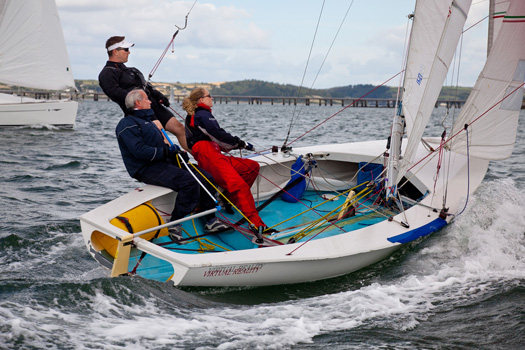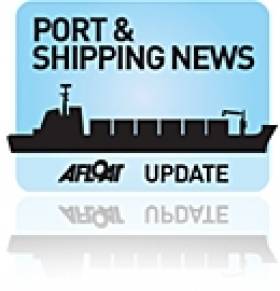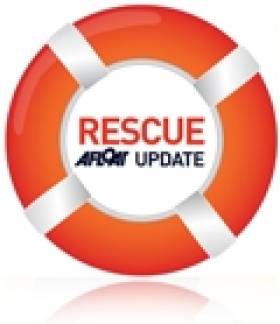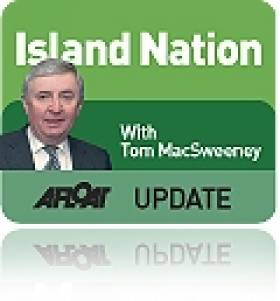Displaying items by tag: Cork Harbour
Salt Shipments Bound for Cork
In total the National Roads Authority (NRA) will have 25,000 tonnes of salt available during the Christmas week, with 3,000 tonnes distributed to authorities on a daily basis. As a priority the salt will be used to grit the national primary network.
The second bout of artic conditions that has gripped the country with temperatures plummeting to -17 degrees in the west and -15 degrees is forecast tonight in the north-west. Further snowfalls are also due in various regions tonight and with sub-zero temperatures expected to last up to St. Stephens Day. As such the demand for salt supplies has soared resulting in shipments sourced from overseas countries to include Turkey and Egypt.
CFL Prospect (see video-clip here) is owned by the Dutch shipping company, Kees Koolhof which since 2006 has built up a fleet of modern vessels to trade in the short-sea sector. The 2007 built vessel is one of nine Jumbo 6500s from a series completed by the Peters Shipyard at Krampen.
For the latest NRA's road weather stations logon here in addition to weather forecasts from www.met.ie
World Leader in Offshore Simulation Partners with National Maritime College
SEFtec NMCI Offshore Ltd (SNO), a public / private joint venture between SEFtec Global Training Ltd and The National Maritime College of Ireland (NMCI), will be launched tomorrow at the National Maritime College, Co. Cork, by the Minister of Enterprise, Trade & Employment, Batt O'Keeffe.
This venture is a shining example of how to bring together state of the art public infrastructure, in the form of one of the world's most advanced maritime colleges, with private enterprise's expertise in not only offshore training, but in the design, manufacture, installation, commissioning and service of training simulators for the global maritime industry.
The Minister for Enterprise, Trade and Innovation, Batt O'Keeffe TD, who launched the public-private joint venture, said it would support jobs and the growth of the Irish offshore exploration and wind energy sectors. 'The future is bright for the partnership we are announcing here this afternoon. The maritime sector is a diverse and developing global industry that requires huge levels of skill and technical capability,' said Minister O'Keeffe.
Focused on supporting the successful and sustainable growth of the Irish offshore exploration sector, SNO has successfully secured the approval of the Offshore Petroleum Industry Training Organization (OPITO) for its programme of courses. In a sector that is completely focused on safety,OPITO has become the global industries focal point for skills, training and workforce development.
"SNO is very proud to have achieved its OPITO approval this year, the approval came about in a phenomenal time frame and this wouldn't have been possible without the combined efforts of both public and private joint venture partners. This will mean that we can service not only the growing needs of Ireland's offshore sector, but train for the global industry as well" Conor Mowlds, Managing Director SNO Ltd.
SEFtec, an Irish SME with a global focus, commenced trading in 2004 and has quickly become one of the world's leaders in the provision of offshore simulation equipment. Based in a state-of-the-art facility in Cork it has diversified its activities from the design and fabrication of offshore training simulation equipment to training and already operates an OPITO centre in Kazakhstan.
The NMCI, a public private partnership between the Cork Institute of Technology, Vita Lend Lease and the Irish Naval Service was opened in 2004, represents a €60 million investment by the state in maritime training, and is one of the world's most advanced maritime colleges.
The future aim of SNO is to break into the offshore renewable energy sector, with the development of their Offshore Wind Energy Safety Training course (OWEST) ear marked for further development. The OWEST course currently involves Helicopter Winching Techniques, Life Saving Appliances and Vessel Abandonment which is key training for anyone working on or near Offshore Wind Energy Sites.
See below for photos taken this morning at the National Maritime College in Ringaskiddy of delegates on the OPITO approved BOSIET - Offshore Training Course, using the Helicopter Underwater Training Simulator
Emergency Salt Shipments Supplies Due To Arrive
Two vessels, the CSL Prospect and Olivia are heading for the Port of Cork with a combined cargo of 11,500 tonnes of salt. In the meantime councils are coping with rapidly dwindling supplies to keep the main roads gritted over the weekend. If the councils fail to ration supplies, the authorities will quickly run out of salt, sparking a crisis for motorists. For more on this story click here.
The Port of Cork added that these salt-shipments will continue beyond next week. In addition to next weeks delivery, more vessels will be calling to the port, bringing in total 35,000 tonnes of salt over the next few weeks.
According to weather forecasts, there will be significant accumulations of snow expected in most parts of the country. Up to 10cm of snow may fall over the next few days. For information on the latest weather updates logon to www.met.ie/forecasts/
Selection Procedure for Team Racing Worlds Underway
The selection procedure to designate the teams to represent Ireland at the ISAF Team Racing Worlds is underway.
Teams wishing to be considered for selection should contact the Irish Team Racing Association a [email protected]. A selection committee will then invite teams to trials to be sailed early in 2011. Invitations will be issued on the basis of the results of all team members (helm and crew) in 2009 -2010.
The trials will consist of a multiple round robin event. The Youth trials will be sailed in Crosshaven, and the senior trials in Dun Laoghaire. Unfortunately, the number of places available for Ireland at the World Championships is not yet known, but ITRA will select two senior teams, plus a reserve team, and two Youth teams, plus a reserve.
National 18s -72 Years Old and Still Sailing
My first experience of racing was in a National 18 wooden dinghy and it was rough. Inexperienced as a crewman during a race in Monkstown Bay, I slit the top of a finger across a chain plate while pulling in the headsail sheet.
Blood started to pour out of the cut. With the dinghy having only a short freeboard I did what seemed best. To avoid getting blood on the sail which is a heinous crime aboard sailing boats, I put my hand in the water to wash away the blood.
A roar from astern heralded the Skipper's response:
"Get your b....hand out of the water, you're causing drag," which meant I was being accused of the crime of slowing the boat down in a race where there was little wind and every bit of forward momentum was important.
I began to explain and made the mistake of asking where I should put my bloodied finger!
The answer is not printable, but taught me that National 18s didn't take competitive sailing lightly.
I grew to love those boats, their beautiful lines, their speed and their demands on the crew with a spinnaker up. Inevitably, with the cost of maintaining wooden boats, the glass fibre boats (GRP), took over, but the National 18 Class kept going, primarily based in Crosshaven.
Then the 1720s arrived, named after the year when the Royal Cork Yacht Club was founded, powerful new boats which were predicted to wipe out the National 18s. They didn't. Despite becoming very popular for a time, their support declined and the National 18s continued, not alone surviving, but strengthening
This week the Class has announced that it intends to host "the largest gathering of National 18s in the history of this legendary boat."
Next year's Class Championships, better known as the Cock O' the North and sailed in alternative years in Ireland and the UK, where the National 18 is also popular, will be held in Crosshaven from July 24 to 29.
"We are calling on everyone interested to get in touch and take part in what is going to be a great occasion, whether you are a former 18 sailor or someone looking for a new challenge," Class Captain Peter O'Donovan told me. "We are putting in a big effort to get former 18 sailors and their boats back on the water."
It is hoped that at least 50 boats will take part "and perhaps even more," said Peter who has been trawling class records to find former owners and boats which will be arranged in three divisions for the event.
"We decided to include a Classics section, which will encourage those who owned the beautiful wooden, clinker boats, to sail again with us. Some of these boats have reappeared in Crosshaven, we know of others in West Cork and further afield," said Peter.
There will be a section for the "Penultimates," the older fibreglass 18s which "have been hiding in garages, just waiting to be taken out again" and the "Ultimates," the modern fibreglass boats at the front of the present fleet.
"We want to make this a special event and so far there has been interest from Schull, Baltimore, Waterford, Wexford, Arklow and Lough Derg. Further afield, we expect to see visitors from Scotland, the Isle of Man, Essex, Tamesis and Chichester Harbour and we have even had a request for information from Germany."
One of the famous boat building family in Arklow, James Tyrrell, is amongst those who have owned and sailed a National 18. Another sailor of the boats was Peter Crowley, present Chairman of the Irish Sailing Association.
He sailed with Tommy Dwyer from Monkstown who is regarded as an icon of the National 18 fleet in Cobblerod. Tommy now sails Das Boot.

Fun in the National 18. Photo: Bob Bateman
"She was recovered from the bottom of Cork Harbour and I refurbished her. said Tommy, "We named her after the U-boat which featured in the film of that name."Tommy has been sailing National 18s for over 40 years. Every year his name has been amongst the trophy winners.
"For those interested in sailing, we would like to hear from those who would like to crew in the championships," Peter O'Donovan told me. "In addition, we are compiling a list of boats available for charter across the three divisions. For anyone not looking to sail, but just to be part of the event, we will also require assistance with rescue vessels, committee boats and other aspects of the event. It is also hoped to put together a collection of photographs from days gone. We would like to hear from anybody with material. Former 18 sailors who cannot get involved in the event could join us at the Class Dinner and renew acquaintances."
Anyone interested can contact the National 18 class by Emailing Peter O'Donovan at [email protected] or on phone 087 2491720 or Email Kieran O'Connell at [email protected]
The original idea for the building of National 18s was that of Frank Knowling of Whitstable YC in the UK, who later became known as the 'father' of the class. In 1938 he wanted an 18-foot dinghy, suitable for day sailing, yet fast enough to be of interest to racing sailors and at a reasonable cost.
The UK national sailing association and Yachting World magazine organised a design competition won by well-known designer Uffa Fox with a proposal for a clinker-built wooden boat. Another major designer, ¸, had also submitted a proposed boat. The first National 18 was named 'Hurricane,' owned by Stanley Beale and sailed at Whitstable.
It was not until after World War that building of 18s got underway. The Class Association was established in 1947 and by 1950 fleets had appeared at clubs around the coast of Britain and Ireland.
Seventy-two years after the first moves to build National 18s they still survive, a tribute to a great boat.

This article is reprinted by permission of the EVENING ECHO newspaper, Cork, where Tom MacSweeney writes maritime columns twice weekly. Evening Echo website: www.eecho.ie
Port of Cork Calling all 5th Class Teachers!
School-children will be able to earn about the harbour and how it could be used to harness energy such as wind, wave, gas, electricity and other forms of energy. In addition it will provide an opportunity for the participants to be creative and futuristic about Cork harbour. Children can also look at the importance of green energy in their home and school.
The projects are to be presented in artwork format using paintings, models or photographs. Submitted projects will go on public display in the Cork Customs House for six weeks before the winner is announced in April 2011.
All 5th classes who take part in the Port of Cork Schools Initiative are treated to a boat trip around Cork harbour and each class will receive a certificate of participation. Prizes will be given for the best artwork piece and best photograph.
The overall winner of the Schools Initiative project will receive a tour onboard one of the many cruise liners that are to visit Cork Harbour next summer.
Closing date for entries is 18th March 2011. For further information on this year's schools project and how to get involved you can contact Captain Pat Murphy Tel: 021 4625312 or by Email [email protected] and by logging on to www.portofcork.ie
In addition you can view below a video depicting liners of yesteryear and the cruiseships that visit Cork Harbour, the world's second largest natural harbour.
Fastnet Ferry Figures Smash 2010 Target
The passenger figure represents four-times the capacity of the Liberty Stadium, Swansea which is to host the rugby Heineken Cup clash between Swansea Neath Ospreys and Munster on Saturday 18 December.
The 10-hour ferry service operated by Fastnet Line also carried 31,000 vehicles and statistics suggest a significant boost for the Swansea Bay economy with about 40% of all passengers so far travelling from Cork to the south Wales region. The route is served by the MV Julia which had been sailing in the Baltic. The 1982 built vessel is capable of carrying more than 1,800 passengers and 400 cars.
Fastnet Line will run all-year-round in 2011 and has set a revised target of 120,000 passengers.
On a seasonal note, Christmas gift vouchers are available from Fastnet Line, for more information logon HERE
CMA–CGM Win Port of Cork Sponsored Deep Sea Shipping Award
The Port of Cork was delighted to sponsor the Irish Exporter Awards category, 'Deep Sea Shipping Company'. The award was presented to CMA-CGM Shipping Ireland Ltd for providing global container shipping solutions for companies in all sectors, at an awards ceremony in Dublin's RDS on Thursday 25th November, attended by Minister Batt O'Keefe.
Captain Michael McCarthy, Commercial Manager Port of Cork said: As Ireland's primary deep water port, the Port of Cork has a long term focus on meeting the needs of deep sea shipping lines and understands the importance of growing the export market.'
He continued: 'This is the second year sponsoring such an award and we were delighted to sponsor the Deep Sea Shipping Company Award for 2010. We look forward to supporting the growth of international trade for both current and future economic prospects.'
Other nominees of this category were Dublin based companies: APL Ltd., CMA-CGM Shipping Ireland Ltd. and Maersk Line.
Nicholas O'Leary is Afloat's November Sailor of the Month
Nicholas "Nin" O'Leary of Cork has re-written the Irish sailing records, and he's only 24. The new All Ireland Champion Helm is clear winner of the Afloat.ie/Irish Independent "Sailor of the Month" award for November after a nail-biting finale in difficult conditions off Kinsale, making it three-in-a-row for this junior skipper who was winning major titles with impressive scorelines well before he was out of his teens.
The wind was drawing from the east for the 20th November shootout in the ISA's SailFleet of J/80s. But the challenge lay in the fact that, after a week of strong winds up to gale force, a massive swell was rolling in past the Bulman Buoy to provide sea conditions which were out of sync with the strength of the breeze.
Yet the three top Royal Cork helms showed they were up to the challenge. In fact, it was Neil Kenefick, in the championship through being tops in the ICRA series in 2010, who best got to grips with the racing in the early stages, posting two wins with Anthony O'Leary second in the first race, while son Nicholas was second in the next one.
But the junior O'Leary moved nearer to retaining the title by winning the third, though his father was right there with a second, while James Espey from the Lasers posted a third. However, Kenefick was in touch with a fourth, but that became his discount as he nailed a couple of thirds in the two concluding races.
Going into the fifth and final race, the three Crosshaven helms were neck-and-neck on points, but O'Leary Junior put it neatly away by slicing in ahead of his father, with Kenefick third. The Corkmen were out on their own, as next in line was Puppeteer 22 Champion Garret May, but he concluded with 18 net points, while Neil Kenefick was on 8, Anthony O'Leary on 7, and Nicholas O'Leary the supreme champion on 6. And making a bit of history while he was at it - the first three-in-a-row in the All Ireland's 64 years.
There Is More To The Water Underneath
My time on the water has been spent 'on the surface,' but those who like to go underwater tell me the attractions of diving are magnificent and that Cork Harbour, my sailing base atop the water, is one of the great 'dive spots' on the Irish coastline.
There are many ways to enjoy the water, so I believe in encouraging everyone who takes parts in watersports. That is one way in which appreciation of the importance of the marine sphere can be advanced.
The Irish Underwater Council, Comhairle Fó Thuinn, known by its initials 'CFT,' promotes diving and is the national governing body for recreational underwater sports in Ireland. Through affiliated clubs, it provides training for diving and snorkelling.

"It's time to dive," the CFT says. "We provide the opportunity for recreation and fun in a friendly environment while maintaining a safe and cautious attitude to Irish waters. The basic objective of the training system is to demonstrate, teach and practice all the necessary abilities until the beginner is comfortable with the equipment and basic safety skills. There is no pressure of time limits and training is at the individual's own pace."
The CFT was founded in 1963 when underwater enthusiasts wanted to establish a national group which would organise and promote sport scuba diving and snorkelling. At that time there were six clubs around the country. The number has now expanded to 84.
I was talking in the past week to just one of those clubs - the Cork Sub Aqua Club which is encouraging more people to take up the sport. It has been in existence for 40 years and organises dives on Wednesday evenings during the Summer and on most Sundays throughout the year. There are visits to dive sites outside of Cork and wreck-diving is organised to suit ability and experience. Divers come from all ages and backgrounds, so there is a great opportunity if for anyone interested to get involved.
"We will begin training new recruits in January, so anyone who joins will be ready for open water by the Spring. No experience is necessary," the club says. "Our qualified instructors are waiting for newcomers and, for anyone already qualified, we say join and dive with us."
The photograph on this week's blog shows two divers enjoying their time in the water, even in this cold period of the year. Niall O'Regan from Monkstown in Cork and Ian Kelleher were diving off Roche's Point. They had a look at a trawler which sank in the area back in the mid-80s. The attraction of diving for them is "the great diversity of sea life to be found around the harbour and the quiet and tranquillity underwater in comparison to the hustle and bustle on land." That is a well-expressed sentiment which I like and encourages me to tell you that I am continuing with attempt to develop my idea for the establishment of an Irish maritime foundation. My thanks to those readers of this blog who Emailed me about it. Some good ideas have been put forward and more are always welcome.
For anyone interested you can get more information about the Irish Underwater Council by Emailing: [email protected] or about membership by Email to: [email protected]
You can Email me in response to items on this blog at: [email protected]
This article is reprinted by permission of the EVENING ECHO newspaper, Cork, where Tom MacSweeney writes maritime columns twice weekly. Evening Echo website: www.eecho.ie

































































